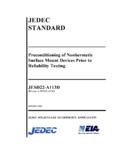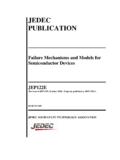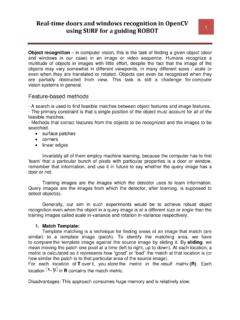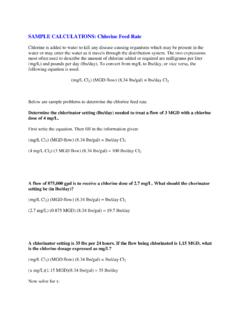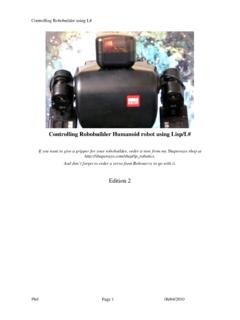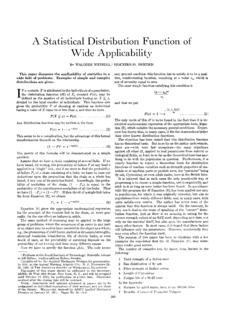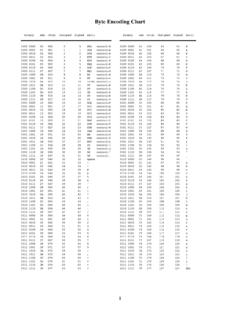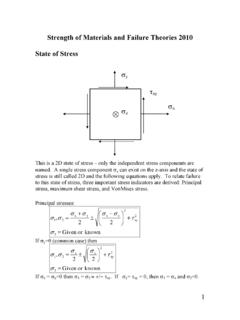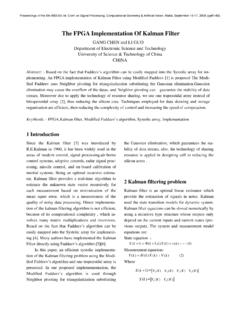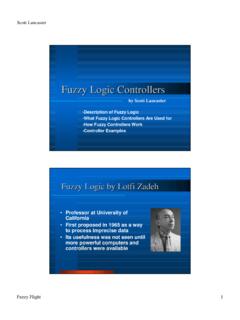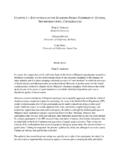Transcription of Zo:Transmission Lines, Reflections, and Termination
1 Transmission Lines, reflections , and TerminationZo 1 Supplementary material to accompanyDigital Design Principles and Practices, Fourth Edition, by John F. 0-13-186389-4. 2006 Pearson Education, Inc.,UpperSaddle River, NJ. All material is protected under all copyright laws as they currently exist. No portion of this materialmay bereproduced, in anyform or byany means, without permission in writing by the :Transmission Lines, reflections , and TerminationNothing happens instantly, especially where digital circuits are concerned. Inparticular, consider the fact that the speed-of-light propagation delay of elec-trical signals inwire is on the order of 2 ns per foot (the exact delay dependson characteristics of the wire).
2 When wire delays are similar to the transitiontimes of the signals that theycarry, we must treat wires not as zero-delay, perfectconductors, but as the transmission lines that they really behavior includes signal changes that would not bepredicted by a DC analysisof circuit mostsignificant changesoccur during an interval of approximately 2T after an output changes state,where T isthe delay from the output to the far end of the wirethatit behavior usually doesn taffect the logical operation ofdevices whose signal transition times and propagation delays are much longerthan 2T. Thus,transmission- line behavior typically is considered only for TTL,74AC, and 74 ACT connections over afoot, and for 74 FCT and ECL connectionsover 3 6 inches.
3 Naturally, you can sometimes get away with longer connectionsdepending on the application, but there are also situations where transmission- line theory must be applied to even shorter connections. Many VLSI chipsachieve high enoughspeeds that transmission- line behavior mustbe consideredin the internalchip Transmission- line TheoryTwoconductors in parallelconstitute the simplesttransmission line . Consider apair ofconductorswith infinite length, as shown in Figure Zo-1(a) on the nextpage. If we instantaneously putavoltagesource across the pair, a certain currentflows to create a voltage wave thattravels along the pair. The ratio of voltage tocurrent,Vout/Iout, depends on the physical characteristics of the conductors andis called thecharacteristic impedance Z0of the conductor magnitude ofVout isdetermined by viewing the series combination ofRsrc and Z0 asavoltage divider, so thatOf course, we don t have any infinitely long conductors.
4 However, supposethat we have a 5-foot-long pair of conductors, and we place a resistance equal toZ0 across the far end. If we instantaneously place a voltage source across the pairas shown in (b), the same current flows forever as in the infinite-length , when a lineis terminatedby its characteristicimpedance,weneedn tconsider transmission- line effectsany situation is different for a transmission line of finitelength that is notterminated in its characteristic impedance. An extreme case, in which the far endis short-circuited, is shown in Figure Zo-2(a). For simplicity, we assume thattransmission linecharacteristicimpedance Z0 VoutVsrcZ0 RsrcZ0+--------------------- =Transmission Lines, reflections , and TerminationZo 2 Supplementary material to accompanyDigital Design Principles and Practices, Fourth Edition, by John F.
5 0-13-186389-4. 2006 Pearson Education, Inc.,UpperSaddle River, NJ. All material is protected under all copyright laws as they currently exist. No portion of this materialmay bereproduced, in anyform or byany means, without permission in writing by the in this example. Initially,all the driver seesis the line scharacteristicimpedance, and a voltage wavewith amplitudeVsrc/2 happily propagates downthe line . However, when the wave hitsthe far end at timeT, it sees the short-circuit. In order to satisfy Kirchhoff s laws, a voltage wave of the oppositepolarity propagates back down the line , canceling the original wave. The far endhas reflected the original wave, andthe driverseesthe short-circuit at extreme case, in which the far end is open-circuited, isshown in(b).
6 Everything starts out as before. However, when the initial voltage wave hitsthe far end, the current has nowhere to go, and soa voltage wave of the samepolarity propagates back up the line , adding to the originalvoltage. When thereflected wave reaches the driver at time 2T, the voltage everywhere isVsrc, andnothing the general case, the amplitude of the wavereflected atthe end of atransmission line is determined by thereflection coefficient, (rho). The valueof depends on Z0 andZterm, the Termination impedance atthe end of the line :When a voltagewave with amplitudeVwavehits theend of a transmissionline, awave with amplitude Vwave is reflected.
7 Notethat three simple cases matchour previous discussion:VsrcVoutV1+Iout IoutVsrcVout00 Rsrcclose switch at t=0 DRIVERRsrc + Z0 VsrcV100 Rsrc + Z0V2 VsrcV200 Vsrc Z0 Vsrc Z0 Vsrc Z0 Rsrc + Z0transmission lineVsrcVoutV1+Iout IoutRsrcDRIVERV2transmission lineR = Z0(a)ttt(b)Figure Zo-1 Transmission lines: (a) with infinite length; (b) with finite length,terminated with coefficient, terminationimpedance ZtermZ0 ZtermZ0+-----------------------=Transmis sion Lines, reflections , and TerminationZo 3 Supplementary material to accompanyDigital Design Principles and Practices, Fourth Edition, by John F. 0-13-186389-4.
8 2006 Pearson Education, Inc.,UpperSaddle River, NJ. All material is protected under all copyright laws as they currently exist. No portion of this materialmay bereproduced, in anyform or byany means, without permission in writing by the a transmissionlineis terminated in its characteristic imped-ance, the reflection coefficient 0 The reflection coefficient of a short-circuited line is 1, producing areflection of equal magnitude and opposite The reflection coefficient of an open-circuited line is+1, producing areflection of equal magnitude and the same the source impedance (Rsrc) does not equalZ0, then reflections occur atthe nearend oftheline aswellas at the far end of the linehas itsownvalue of.
9 The principle ofsuperpositionapplies, so thatvoltage at anypoint onthe line and instant in time is the sum ofthat point s initialcondition and allwaves that have passed itso far. The end of a transmission line is said to bematchedif itis terminated withits on the next page shows the behavior of a transmission line thatis not matchedat eitherend. (Notethat the driver s idealvoltage sourceVsrc isconsidered to have a resistance of 0 for this analysis.) reflections occuratboth ends of the line , with smaller and smaller waves reflecting back and +Iout IoutVsrcVout00close switch at t=0 DRIVERtttVsrcV100V2 VsrcV200transmission line (a)TTT2T2T2 TVsrcVoutV1+Iout IoutVsrcVout00 Rsrc = Z0close switch at t=0 DRIVERVsrc / 2 Vsrc / 2 Vsrc / 2 Rsrc = Z0 Vsrc / 2 Vsrc / 2 Vsrc / 2tttVsrcV100V2 VsrcV200transmission line (b)TTT2T2T2 Tpropagation delay to this point is TFigure Zo-2 Transmission lines: (a) short-circuited.
10 (b) ofsuperpositiontransmission- line matchingTransmission Lines, reflections , and TerminationZo 4 Supplementary material to accompanyDigital Design Principles and Practices, Fourth Edition, by John F. 0-13-186389-4. 2006 Pearson Education, Inc.,UpperSaddle River, NJ. All material is protected under all copyright laws as they currently exist. No portion of this materialmay bereproduced, in anyform or byany means, without permission in writing by the voltage everywhere on the line asymptotically approaches , the valuethat would be predicted by a DC analysis of the circuit using Ohm as Transmission LinesSo,how does transmission-linetheory affect logic signals?
